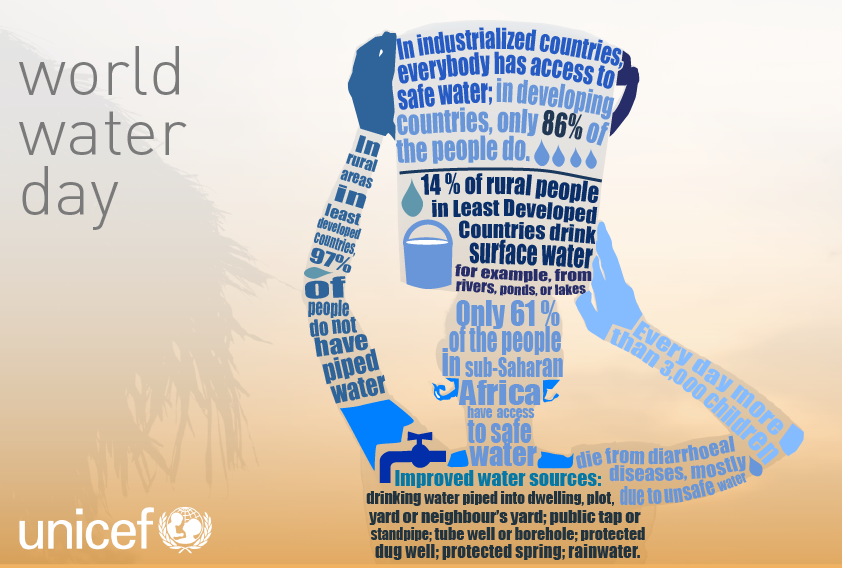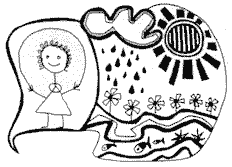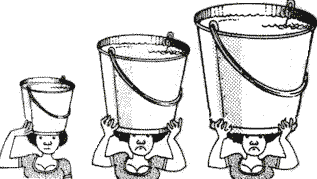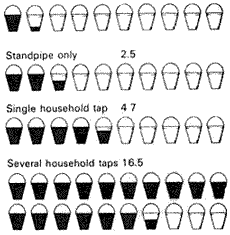|
| |
Water

Water, Sanitation, Hygiene and Health News
Health gains associated with safe drinking water can be achieved by providing
people with simple, affordable technologies, such as chlorination, filtration,
solar disinfection and improved storage in their homes.
Water Facts
Water Facts |
Water |
Children |
Disease |
Economics |
Sanitation |
Women |
One Billion Affected |
The Women's Crisis
 |
“The human right to water entitles everyone to sufficient, safe, acceptable,
physically accessible and affordable water for personal and domestic uses”
–
General Comment No. 15 (2002): The Right to Water
"Water and Sanitation is one of the primary drivers of public health. I
often refer to it as “Health 101”, which means that once we can secure access
to clean water and to adequate sanitation facilities for all people,
irrespective of the difference in their living conditions, a huge battle
against all kinds of diseases will be won."
Dr LEE Jong-wook, Director-General, World Health Organization
“We shall not finally defeat AIDS, tuberculosis, malaria, or any of the
other infectious diseases that plague the developing world until we have also
won the battle for safe drinking water, sanitation and basic health care.”
Kofi Annan, United Nations Secretary-General
"I am utterly convinced that the
number of water taps per 1,000 population will be an infinitely more meaningful health
indicator than the number of hospital beds per 1,000 population."
Dr. Halfdan Mahler, Director-General, World Health Organization
|
How to turn unsafe water into drinkable water
Step 1
If necessary: Remove particles
To remove contamination with solid particles pre-filter the unsafe water with a
piece of cloth or a coffee filter. This method does not remove micro-organism. You still have to disinfect with heat or chemicals.
Step 2a
If possible: Disinfection with heat
Sufficient heat will kill micro-organisms in contaminated water already at a temperature below the boiling point. During the time needed to reach boiling
point the water is heated long enough for disinfection. There is no need to boil water for 5 minutes, 10 minutes, or 20 minutes, as some guide books recommend!
Step 2b
If heat is impossible: Chemical Disinfection
A) With Iodine
Iodine has advantages over chlorine in convenience and efficacy; and the taste
is less offensive. It is safe for short and intermediate length use (3-6 months), but questions remain about its safety in long-term usage. It should not
be used by persons with allergy to iodine, persons with active thyroid disease, or pregnant women. When the iodine is added to the water leave the preparation
for 30 minutes in clear weather or 60 minutes in cloudy weather.
Table of available Iodine preparations:
| Iodine Preparations |
Amount/Liter |
| Iodine Topical Solution 2% |
8 drops |
| Iodine Tincture 2% |
8 drops |
| Lugol's Solution 5% |
4 drops |
| Povidone-Iodine (Betadine®) 10% |
4 drops |
| Tetraglycine hydroperiodide (Globaline®, Potable Aqua®, EDWGT®) 8 mg |
1 tablet |
B) With chlorine
Any common brand of liquid chlorine bleach contains 5-6 % sodium hypochlorite.
For 1 liter of unsafe water use 4 drops chlorine and wait 30 minutes. For 20 liters of water add 80 drops (1 tablespoon or 5 ml) chlorine. Measuring by drops
is more accurate and the preferred method. When the chlorine is added to the water leave the preparation for 30 minutes in clear weather or 60 minutes in
cloudy weather.
Dr. Walter Schrader -
remedi.org
|
TeachUNICEF: Water and Sanitation
The units, lesson plans, videos and stories in this collection of teacher
resources raise student awareness of the problems facing children with
inadequate access to clean water and explore how organizations, agencies and
individuals are working to address the problems.
Background Info: Water and Sanitation
|
|
Water for Life, 2005-2015 - International Decade for Action
 Video: "Water for Life"
produced by
Global Visions [English]
[French]
Real Player
download Video: "Water for Life"
produced by
Global Visions [English]
[French]
Real Player
download
Booklet for the International "Water for Life" Decade
 pdf
20 pages 2.1 mb pdf
20 pages 2.1 mb
Water is essential for life.
Yet many millions of people around the
world face water shortages. Many millions of children die every year from
water-borne diseases. And drought regularly afflicts some of the world’s
poorest countries. The world needs to respond much better. We need to
increase water efficiency, especially in agriculture. We need to free
women and girls from the daily chore of hauling water, often over great
distances. We must involve them in decision-making on water management. We
need to make sanitation a priority. This is where progress is lagging most.
Kofi A. Annan, 22 March 2005 |
WHO | Water, Sanitation and Hygiene links to Health: Facts and Figures
updated November 2004
 29 kb 29 kb
Diarrhoea
- 1.8 million people die every year from diarrhoeal diseases (including cholera); 90% are children under 5, mostly in developing countries.
- 88% of diarrhoeal disease is attributed to unsafe water supply, inadequate sanitation and hygiene.
- Improved water supply reduces diarrhoea morbidity by between 6% to 25%, if severe outcomes are included.
- Improved sanitation reduces diarrhoea morbidity by 32%.
- Hygiene interventions including hygiene education and promotion of hand washing can lead to a reduction of diarrhoeal cases by up to 45%.
- Improvements in drinking-water quality through household water treatment, such as chlorination at point of use, can lead to a reduction of diarrhoea episodes by between 35% and 39%.
more |
Water Facts: Children
From water.org:
http://water.org/water-crisis/water-facts/children/
Diarrhea remains in the second leading cause of death among children
under five globally. Nearly one in five child deaths – about 1.5 million
each year – is due to diarrhea. It kills more young children than AIDS,
malaria and measles combined. (13)
Every 20 seconds, a child dies from a water-related disease. (2)
Diarrhea is more prevalent in the developing world due, in large part, to
the lack of safe drinking water, sanitation and hygiene, as well as poorer
overall health and nutritional status. (13)
Children in poor environments often carry 1,000 parasitic worms in their
bodies at any time. (8)
In the developing world, 24,000 children under the age of five die every
day from preventable causes like diarrhea contracted from unclean water.
(13)
1.4 million children die as a result of diarrhea each year. (11)
Resource Links
Look for more facts in our collection of
Water Resource
Links.
References
-
2006 United Nations Human Development Report.
- Number estimated from statistics in the 2006 United Nations Human Development Report.
- Asian Development Bank web site. 2009.
-
The Discovery Channel web site. 2009.
- UNICEF/WHO. 2008.
Progress on Drinking Water and Sanitation: Special Focus on Sanitation.
- UN. 2007.
International Year of Sanitation Global Launch
- UN Water. 2008.
Gender, Water and Sanitation: A Policy Brief.
- UN Water. 2008.
Tackling a Global Crisis: International Year of Sanitation 2008
- Water Supply and Sanitation Collaborative Council (WSSCC). 2008.
A Guide to Investigating One of the Biggest Scandals of the Last 50 Years.
-
Rajesh Shah of Blue Planet Run Foundation.
- World Health Organization. 2008.
Safer Water, Better Health: Costs, benefits, and sustainability of interventions to protect and promote health.
-
World Health Organization Fact Sheet Health in Water Resources Development.
- Diarhhoea: Why children are still dying and what can be done.
UNICEF, WHO 2009
- United Nations World Water Development Report,
"Water in a Changing World"
-
DfiD [Department for International Development] Sanitation Reference Group. 2008.
- 2004, Wastewater Use in Irrigated Agriculture
- (sewer illustration)
Boston Water and Sewer Commission
|
Water Facts and Figures
- 1.1 billion people in the world do not have access to safe water,
roughly one-sixth of the world’s population.
- 2.4 billion people in the world do not have access to adequate
sanitation, about two-fifths of the world’s population.
- 1.35 million people in developing countries, most of them children,
die every year from diseases associated with lack of access to safe
drinking water, inadequate sanitation and poor hygiene.
- Some 3,300 children die every day from diseases associated with lack
of access to safe drinking water, inadequate sanitation and poor hygiene
– equivalent to 10 jumbo jets crashing every day.
- At any one time it is estimated that half of the world’s hospital
beds are occupied by patients suffering from water-borne diseases.
- 200 million people in the world are infected with schistosomiasis, of whom 20 million suffer severe consequences. The disease is still found in 74 countries of the world. Scientific studies show that a 77% reduction of incidence from the disease was achieved through well designed water and sanitation interventions.
- The average distance that women in Africa and Asia walk to collect water is 6 km.
- The weight of water that women in Africa and Asia carry on their heads is the equivalent of your airport luggage allowance (20kg).
- The average person in the developing world uses 10 litres of water a day.
- The average person in the United Kingdom uses 135 litres of water every day.
- One flush of your toilet uses as much water as the average person in the developing world uses for a whole day’s washing, cleaning, cooking and drinking.
- Comparative costs: In Europe $11 billion is spent each year on ice
cream; in USA and Europe, $17 billion is spent on pet food; in Europe
$105 billion is spent annually on alcoholic drinks, ten times the amount
required to ensure water, sanitation and hygiene for all.
- In the past 10 years diarrhoea has killed more children than all the
people lost to armed conflict since World War II.
- In China, India and Indonesia twice as many people are dying from
diarrhoeal diseases as from HIV/AIDS.
- In 1998, 308,000 people died from war in Africa, but more than two
million (six times as many) died of diarrhoeal disease.
- The population of the Kibeira slum in Nairobi, Kenya pay up to five
times the price for a litre of water than the average American citizen.
- An estimated 25% of people in developing country cities use water
vendors purchasing their water at significantly higher prices than piped
water.
- Projections for 2025 indicate that the number of people living in
water-stressed countries will increase to 3 billion – a six-fold
increase. Today, 470 million people live in regions where severe
shortages exist.
- The simple act of washing hands with soap and water can reduce
diarrhoeal disease by one-third.
- Following the introduction of the Guatemalan Handwashing Initiative
in 1998, there were 322,000 fewer cases of diarrhoea each year amongst
the 1.5 million children under 5 nationwide in the country's lowest
income groups.
- In Zambia, one in five children die before their fifth birthday. In
contrast in the UK fewer than 1% of children die before they reach the
age of five.
- A study in Karachi found that people living in areas without
adequate sanitation who had no hygiene education spend six times more on
medical treatments than those with sanitation facilities.
- Waterborne diseases (the consequence of a combination of lack of
clean water supply and inadequate sanitation) cost the Indian economy 73
million working days a year. And a cholera outbreak in Peru in the early
1990s cost the economy US$1 billion in lost tourism and agricultural
exports in just 10 weeks.
- Improved water quality reduces childhood diarrhoea by 15-20% BUT
better hygiene through handwashing and safe food handling reduces it by
35% AND safe disposal of children’s faeces leads to a reduction of
nearly 40%.
- At any time, 1.5 billion people suffer from parasitic worm
infections stemming from human excreta and solid wastes in the
environment. Intestinal worms can be controlled through better
sanitation, hygiene and water. These parasites can lead to malnutrition,
anaemia and retarded growth, depending upon the severity of the
infection.
- It is estimated that pneumonia, diarrhoea, tuberculosis and malaria,
which account for 20% of global disease burden, receive less than 1% of
total public and private funds devoted to health research.
- Ecological sanitation is one option being practised in some
communities in China, Mexico, Vietnam, etc. Excreta contains valuable
nutrients. We produce 4.56 kg nitrogen, 0.55 kg phosphorous, and 1.28 kg
potassium per person per year from faeces and urine. This is enough to
produce wheat and maize for one person every year.
- One gramme of faeces can contains:10,000,000 Viruses, 1,000,000 bacteria, 1,000 parasite cysts, 100 parasite eggs.
For more information, check
http://www.wsscc.org/
Water Supply and Sanitation Collaborative Council c/o WHO (CCW), 20 Avenue Appia, CH-1211 Geneva 27, Switzerland. Tel. +41 22 791 3544, fax +41 22 791 4847, e-mail: [email protected]
Sources
- 5, 7, 8, 9, 10, 11, 13, 14, 15, 21, 22, 23, 24, 25: WaterAid
- 6, 25: WELL Technical Brief (http://www.lboro.ac.uk/)
- 16: Water for African Cities presentation, Stockholm Water Symposium, August 2001
- 12: Vision 21 – Water For People, March 2000, WSSCC
- 1, 2, 3, 4, 19: WHO/UNICEF/WSSCC Global Water Supply and Sanitation Assessment 2000 Report
- 17: WELL Planned Work studies 163 and 164.
- 20: Saadé et al (2001) The Story of a Successful Public-Private Partnership in Central America: Handwashing for Diarroheal Disease Prevention. BASICS, EHP, UNICEF, USAID and The World Bank
- 27: (Esrey and Andersson (1999), Environmental Sanitation from an Ecological Systems Approach. See:
www.wsscc.org)
- 26: (10/90 Report on Health Research, 2000. Global Forum for Health Research)
- 18: (IHE Newsletter, January 2001)
- 28: (Advocating Sanitation - how, why and when? Sanitation Connection:
http://www.sanicon.net/titles/topicintro.php3/topicId=1)
|
|
Health
The World Health
Organization has estimated that 80% of all sickness and disease in the world is
attributable to inadequate water or sanitation.
This includes:
- effects of drinking contaminated water
- water acting as a breeding ground for carriers of disease
- disease caused by lack of washing
Half the people of the world, over 2 billion men, women and children, lack easy access to an adequate
supply of pure, fresh water. In rural areas, where the situation is worst, 29% have access
to safe water supplies and still fewer, 13% have sanitary facilities.
It has been estimated that if clean water were universally available, the world rate of infant
mortality could be halved, primarily through eradication of diarrhoeal diseases.
Diarrhea directly kills 1.8 million children in developing countries each year, and contributes to the death
of up to 15 million people.
Courier
Loss of Labor
Those who are ill cannot work productively, but even among those who are well, tremendous time and energy
are wasted in the daily search for water.
- In one village in Burkina Faso, a country in West Africa mothers walk for two to three hours a day to find a river or stagnant pond, and return to their homes carrying 25 kilograms(55 lbs.) of water in earthenware jugs on the heads.
- In some slums surrounding the cities of developing
countries, families often have to spend 10% of their income to buy water for household needs.
Courier
Water and Farming
Agriculture accounts for 70% of total global fresh water use.
1/3 of today's harvest comes from 17% of the world's cropland that is irrigated. Irrigation thus greatly helps meet the challenge of feeding an ever-growing population.
Worldwatch Paper 62
Irrigation can also degrade the soil. Much irrigation water is salty, causing an increased need for
fertilizers.
Beyond Oil
Shrinking inland seas are a dramatic consequence of large water withdrawals to meet irrigation and other
water demands. An equally grave threat is the quiet loss of fish and other aquatic life
from rivers and streams whose altered flow patterns can no longer sustain them.
Raising irrigation efficiencies worldwide by just 10% would save enough water to supply all global residential water uses.
Worldwatch Paper 62
Enough for survival enough for health
Two thirds of our bodies weight and nine tenths of its volume is water.
That is why water essential for life. People can survive for up to two months without food, but die within three days without water
 |
A person needs about 5 litres of water each day for
cooking and drinking. But the World Bank estimates that a further 25-45
litres are needed for each person to stay clean and healthy. In many
places the family's water must be fetched each day by women or children. |
|
In Kenya alone, it is estimated that 3 million women each spend an average of 3 hours a days on the single
task to fetching water - that equals 9 million hours daily.
Is There a Better Way?
|

|
- The most a woman can carry in comfort is 15 litres, each litre weighing one kilogram.
- If she carries only enough water for her family (husband, mother, five children) to survive each day, she would need to fetch about 40 litres.
- But to keep them all clean and healthy she would need to fetch 200 litres of water every day.
This is why the amount of water consumed depends largely on whether it has to be carried to the house.
|
Type of Facility
Approximate consumption per person in 10-litre buckets.
No tap or standpipe 1.2 |
 |
Meanwhile people in the industrialised world use
- 22 litres each time a toilet is flushed
- 150,000 litres to produce a ton of steel
- 750,000 litres to produce a ton of newsprint
Sources:
- Beyond Oil: The Threat to Food and Fuel in the Coming Decades, A Summary Report. 1986. Carrying Capacity. Inc., 1325 G Street, NW, Suite 1002, Washington, D.C. 20005.
- Courier, January 1985, a publication of UNESCO, 7 Place de Fentenoy, 75700 Paris.
- Decade Watch, International Drinking Water Supply and Sanitation Decade, published quarterly by the United Nations Development Programme. Division of Information, One UN Plaza. New York, NY 10017.
- EPA Journal, Vol. 12 No. 7, September 1986 and Vol. 11. No. 7, September 1985, United States Environmental Protection Agency, Office of Public Affairs, Washington. DC 20460.
- Is There a Better Way? June 1985, United Nations Development Program, Division of Information, New York, New York 10017.
- The New Internationalist, No. 103, September 1981, 175 Carlton St., Toronto. Ontario M5A 2K3; for subscription enquiries: P O Box 1143, Lewiston, NY 14092.
- The Real Cost, Richard North, 1986, Chatto and Windus Ltd., 40 William IV Street. London WC2N 4DF.
- State Government News, Vol. 29 No. 5, June 1986, The Council of State Governments. Iron Works Pike, P O Box 11910, Lexington, KY 40578.
- World Military & Social Expenditures 1986, Ruth Leger Sivard, World Priorities, Inc., Box 25140, Washington, DC 20007. Worldwatch Paper 62 Water: Rethinking Management in an Age of Scarcity, December 1984 and
- Worldwatch Paper 64 Investing In Children, June 1985, The Worldwatch Institute, 1776 Massachusetts Avenue, NW, Washington, DC 20036.
Produced by
Office on Global Education, National Council of Churches,
2115 N. Charles St., Baltimore, MD 21218- 5755
A Program of the Divisions of Education and Ministry, and Church World Service
|
|
Water Related Links World Water Day 2005
United Nations Educational Scientific and Cultural Organization;
presentations of the WWD 2005
World Health Organization; an advocacy guide
Management of Water Resources
United Nations Development Programme; UNPD and Water
World Water Council
UNESCO; World Water Assessment Programme
The 4th World Water Forum, 2006
Freshwater
International Year of Freshwater, 2003
United Nations Department of Economic and Social Affairs; Freshwater, interagency activities
Freshwater Resources at UNEP
Water-related issues and Education
UNESCO: Education for sustainable development
United Nations Decade for Human Rights Education, 1995-2004
Water and Disasters
Water World Day 2004, Water and Disasters
International Strategy for Disaster Reduction; news
Water and Sanitation
WHO: Water, Sanitation and Health
Others
Calendar of the UN water-related events
UN Millennium Project
International Strategy for Disaster Reduction, International Decade for Natural Disaster Reduction
United Nations Library
Small Islands, Big Issues
Media Information
Press Releases/Statements and Media inquiries
UN Newscentre
Water Books A River No More by Philip L. Fradkin
A Story That Stands Like a Dam: Glen Canyon and the Struggle for the Soul of the West by Russell Martin
Blue Gold: The Fight to Stop the Corporate Theft of the Worlds Water by Maude Barlow and Tony Clark
Bottlemania: How Water Went on Sale and Why We Bought It by Elizabeth Royte
Cadillac Desert: The American West and Its Disappearing Water by Mark Reisner
Dry Spring: The Coming Water Crisis of North America by Chris Wood
Dying Wisdom: Rise, Fall and Potential of India’s Traditional Water Harvesting System published by the Centre for Environment and Science
Food and Water: Threats, Shortages and Solutions by Bernard S. Cayne (Editor) and Jenny E. Tesar
From Reclamation to Sustainability: Water, Agriculture and the Environment in the American West by Lawrence J. MacDonnell
Global Change: Enough Water for All? by by José L. Lozán / Hartmut Grassl / Peter Hupfer / Lucas Menzel / Christian-D. Schönwiese
Keepers of the Spring: Reclaiming Our Water in an Age of Globalization by Fred Pearce
Last Oasis: Facing Water Scarcity by Sandra Postel, Linda Starke (editor)
Life’s Matrix: A Biography of Water by Phillip Ball
Making Water Everybody’s Business (a continuation of Dying Fall) published by the Centre for Environment and Science
Pillars of Sand: Can the Irrigation Miracle Last? by Sandra Postel
Reflected in Water: A Crisis of Social Responsibility by Colin Ward
Rivers for Life: Managing Water for People and Nature by Sandra Postel
Rivers of the Green Swamp: An Anthology by a collective of Florida writers, academics, and graduate students at the U. of South Florida – St. Petersburg.
Take Me to the Source : In Search of Water by Rupert Wright
The World’s Water by Peter H. Gleick
The Sound of Mountain Water by Wallace Stegner
Thirst: Fighting the Corporate Theft of Our Water by Alan Snitow & Deborah Kaufman, with Michael Fox
Troubled Waters: Confronting the Water Crisis in Australia’s Cities edited by Patrick Troy
To The Last Drop by Andrew Wice
Water: A Natural History by Alice Outwater
Water: A Resource in Crisis by Eileen Lucas
Water Engineering in Ancient Civilizations: 5000 Years of History by Pierre-Louis Viollet
Water Follies: Groundwater Pumping and the Fate of America’s Fresh Waters by Robert Glennon
Water for Sale: How Business and the Market Can
Resolve the World’s Water Crisis by Fredrik Segerfeldt
Water: Rethinking Management in an Age of Scarcity by Sandra Postel
Water: The Fate of Our Most Precious Resource by Marq De Villiers
Water: The International Crisis by Robin Clarke
Water Voices by 77 authors, editor, William E. Marks
Wellsprings: A Natural History of Bottled Spring Waters by Francis Chapelle
When the Rivers Run Dry: Water, the Defining Crisis of the Twenty-first Century by Fred Pearce
Who Owns the Water? by Klaus Lanz (Editor), Lars Müller (Editor), Christian Rentsch (Editor), René Schwarzenbach (Editor)
Whose Water Is It?: The Unquenchable Thirst of a Water-Hungry World by Bernadette Mcdonald
|
updated: 23 August, 2019
|